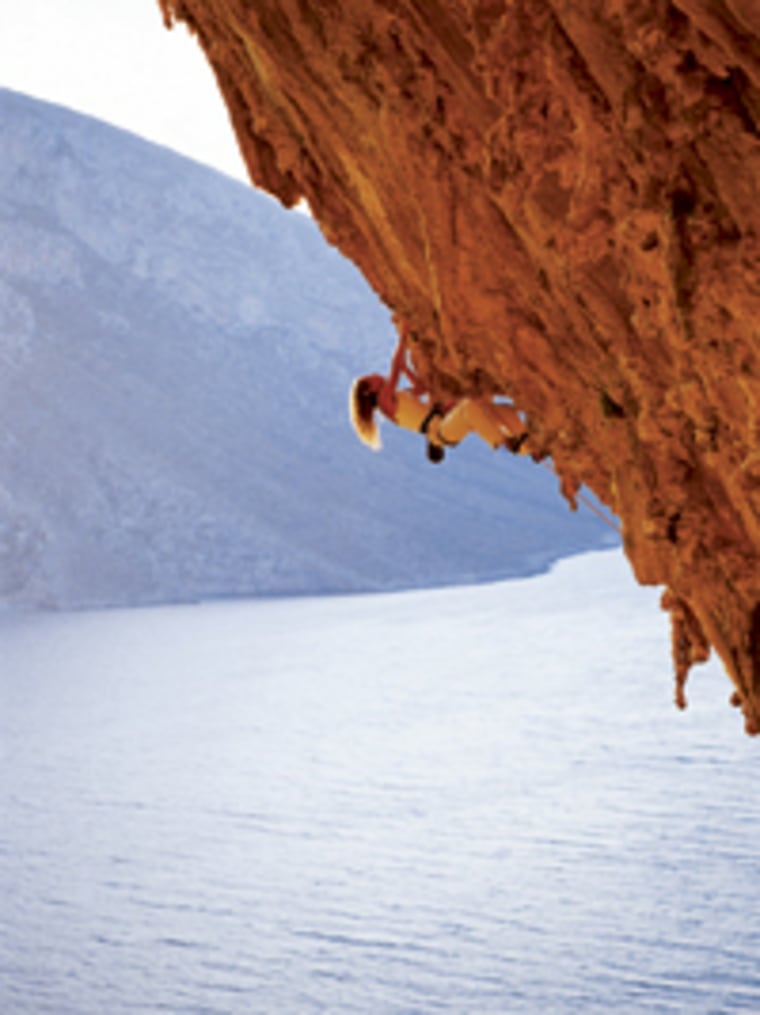The street is dark and quiet except for the laughter of a group of climbers stumbling back from a bar and the far-off whine of a scooter. I hear the surf on the gravel beach of the Greek island of Kalymnos, a small, rocky outcropping in the Dodecanese near the coast of Turkey, and my thoughts are of steep moves on climbs whose names end in “-os.”
Omiros, Kerveros, Eros — the routes are tipped-back concoctions of pockets and tufas and stalactites, and my forearms remember them as a butt remembers a spanking. Listening to the night through the open window and replaying the day, I breathe in the cool air. Into my mind drifts the slogan on the hotel lobby poster: “A climbing paradise in the Aegean ...”
From the balcony I can see the silhouette of the even smaller island of Telendos, separated from Kalymnos 800 years ago, when an earthquake wracked this part of the island. This earthquake might have exposed the limestone cliff line that now looms over the narrow strip of beach towns where the climbers stay. With a dozen sectors spanning several kilometers, this unbroken cliff band is one of the largest single sport-climbing crags in Europe, but surprisingly few people have yet heard of it. Though Kalymnos appears in Homer’s Iliad for deeds done 3000 years ago, it has been known to climbers only since 1996.
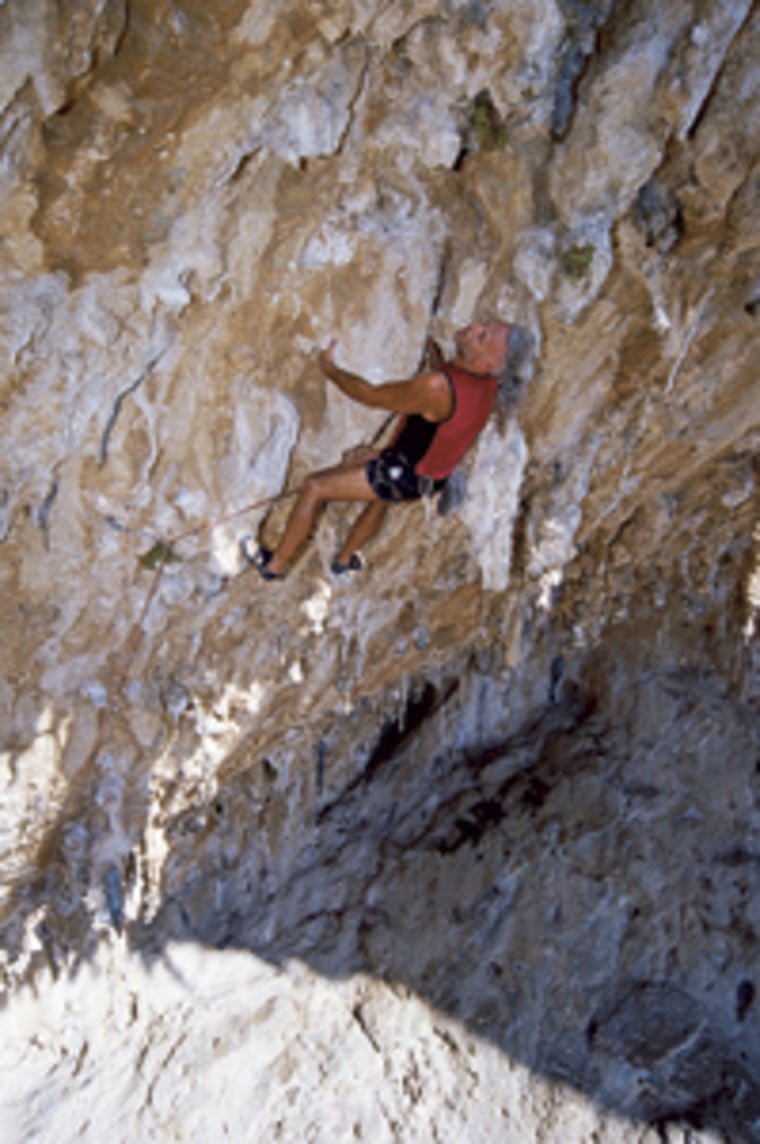
For the past week, life has been idyllic: coffee at one of the cafés that line the town’s one and only through street, head to the crag for a half day of fantastic sport climbing until we can’t close our hands or the sun hits the rock, hit the beach for a while, maybe do a few more routes in the late afternoon, then walk the main street looking for someone we know at the open-air bars, stroll to a restaurant for a late dinner beginning with fresh calamari or feta followed by mousaka or fish, maybe back to a bar, avoiding the Ouzo, and try to make it to bed in time to get up and do it all over again.
In addition to the main escarpment behind town, there are a dozen other crags scattered along the road that follows the island’s northwest coast and more remote sectors on the flanks of inland mountains or along road less stretches of coastline. This week, a French group has chartered a boat from the port town of Pothia and sailed up the coast to put up the first climbs in a huge, stalactite-filled cave far from any road, camping there for several days. Similar grottos exist farther along the coasts — not to mention what you might find if you actually set sail. One Swiss climber, in fact, has arrived in his own boat. His sloop is under repair in Pothia, but in the bar in Masouri he tells of unclimbed limestone on a remote island chain, lost at sea not far away.
Yet after over a week on the island, we have barely escaped the sectors that are walking distance from our room. Every time we take a different approach trail we encounter another day’s worth of routes. The greatest local hazard is a Greek named Manellis, the friendly bartender next door to our hotel. As I fall asleep, I am thankful that tonight we slipped by before he could lure us in with a disco mix and some new concoction from behind the counter.
“Arghh!” High on the wall, Tracy arcs gracefully through the air, abandoning her sprawled pose on small handholds for a swan-like dive into a no-hands rest, twenty-five feet lower on the end of the rope. Hanging the quickdraws on her project, she found herself hopelessly pumped and faced with a classic choice: clip or go. To do both was not an option. Choosing the latter, she missed a hold and flew.
The other climbers who have paused in their activities to observe her effort smile with approval — determination has trumped fatigue and fear, to be trumped in turn by a flaming pump. It is a beautiful thing. Tracy rests on the rope, opening and closing her hands, lightly kicking the wall and gazing up with a mix of amazement at the spectacular nature of her rejection and simple frustration at sixty feet of hard climbing repeated again for no credit. I sit back on the rope with a smile and gaze out at the sea.
“How many different ways can you fall off one climb?” she asks later, rolling her eyes, tender fingers wrapped around a cold Mythos beer at the cafe. “I don’t know, girl,” I tell her, “but that way was one of the best.”
We were actually invited to paradise, guests at an “international climbing festival.” As a tourist destination, Kalymnos struggles in the shadow of much more luxurious nearby resorts, and has embraced traveling climbers more warmly than almost anywhere I know. This festival expresses that. Its official aims are to promote cooperation and friendship between climbers, open new climbing routes, and “build the ties that form from getting to know the people, the culture, and the natural beauties of a place.”
Sounded good to us. Once on the island —we arrived by boat, the only way — we were immediately swept into the festivities. Our first encounter with the Greeks proved typical: George Hatzismalis, a handsome, suave man in his early forties, master troubleshooter for the event, met us at the port with a warm, “Kalimera, Jeff. Kalimera, Tracy.” Exuding a calm energy that completely belied the chaotic schedule he kept, he loaded our gear into his tiny car, then sped away, maintaining a constant narrative on the event and the culture of the island, with brief pauses to speak in rapid-fire Greek into his constantly ringing cell phone. Double-parking in a crowded street, George dashed into a hardware store where he secured a few drill bits, then headed inland to an outdoor café in a small plaza, where we rendezvoused with French climbing ace Daniel Dulac, who took possession of the drill bits, then disappeared in a cloud of dust toward some new crag on his scooter, as we continued on to festival central.
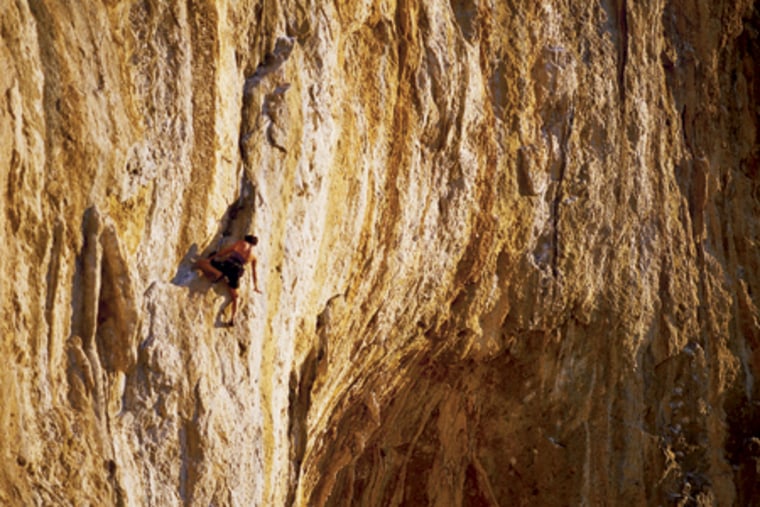
Aside from us and David Graham, who currently resides in Switzerland, the festival’s other invited guests were from Europe, and included many of the island’s earliest climbing explorers. Famous faces were everywhere — Liv Sansoz, Francois Legrand, and Daniel Dulac of France, Michel Piola of Switzerland, Andrea Di Bari and Manolo of Italy, Mirjam Verbeek of the Netherlands. There were journalists — David Munilla from the Spanish magazine Desnivel, Volker Leuchsner from Germany’s Klettern. Since so few Europeans speak the host language of Greek, the most widely used speech in the tourist zones of Kalymnos is English, rendering the international café tables unusually accessible to visiting Americans.
Central to the event was Aris Theodoropolus, the local expert on Kalymnos climbing. Personable and soft-spoken, Greece’s first professional mountaineer, Aris has been climbing for twenty-five years. He cut his teeth establishing adventure routes in the more traditional Greek areas such as Varasova on the south coast of the Greek mainland. Aris is a well-traveled skier and mountaineer as well as an excellent rock climber, with a resume from the Alps that includes ascents such as the American Direct on the Dru, and he now spends half the year on Kalymnos facilitating climbing-related activities. He is responsible for many of the area’s fine sport routes, to which we would sacrifice much skin.
We are not superstars, and our sport-climbing conquests are American trad-climber style: dramatic, deep-digging onsights of the island’s easy classics. The Europeans around us are performing at a considerably higher standard, voiding our bragging rights — which we work to our benefit. Instead of attempting to milk our unimpressive achievements for ego gratification, we focus on making new friends and looking for whimsical significance in other realms, such as the mythological names of the climbs we try.
Tracy’s project is called Daphne, which literally means laurel, the twigs used to make the little wreath that Olympians wear. Long and technical, earthy and elusive, Daphne is proving a worthy opponent. This, we discover, is her mythic nature. In ancient times the lovely nymph Daphne, a disciple of Artemis, virgin goddess of the hunt, used all manner of evasion before finally turning herself into a laurel tree to flee the attentions of Apollo — just as this beautiful climb seems to throw trick after trick to thwart my determined partner.
Priapos, a route I am eyeing in the incredible Grande Grotta sector, is named after a comically uncouth god of fertility. Son of Aphrodite and either Zeus, Apollo, or Bacchus, depending on which myth you read, Priapos is so massively virile that in practice he is sterile. The route holds a similar paradox. It is so steep that it allows you to beat gravity. You climb as much out horizontally as up, gaining half the height you would on vertical moves, so it takes surprisingly little power to pull from feature to feature. Instead of pulling up for the next hold, you lean back to it. Plentiful stalactites provide all manner of exotic and erotic rests. I was used to climbing at “slabbier” areas such as my local crag, Rifle, Colorado, and it took me a while to learn to think in three dimensions, the most significant being out.
In the many hours when we were not actually gripping steep rock, we found the Grande Grotta to be an excellent place for people-watching. At certain times, the spectacular amphitheatre became a virtual planetarium of elite Euro-stars contrapuntally onsighting the wildly overhanging 7c to 8a+ lines. On one visit to the cave, I watched François Legrand working his way through the routes. I had seen this man climb once before, at the Rockmaster competition in Arco, Italy — the see-and-be-seen Wimbledon of sport climbing held outdoors beneath the castle-encrusted cliffs lining the Sarca River at the foot of the Dolomites. The most memorable thing about that competition had been watching Legrand. “He never bends his arms,” someone put it to describe his style — which was part of it, but there was a further effortlessness that defied description.
Being a cynical trad, however, I assumed that Legrand, the ultimate French plastic competition climber, would be less impressive on rock. He looked good on the trade routes well within his grade, no doubt, but surely he’d be too irritated by awkward holds or smudges of dirt here and there to really perform on something as raw as the seldom-tried project in Kalymnos under which he was soon stacking his rope. Yeah, right. The route in question, Fun de Chichunne, was of historical interest. Bolted in 2001, it had been tried by many Greeks and foreigners, but never thoroughly cleaned and never redpointed. The journalist in me also had identified the climb as a potential source of mini-drama.
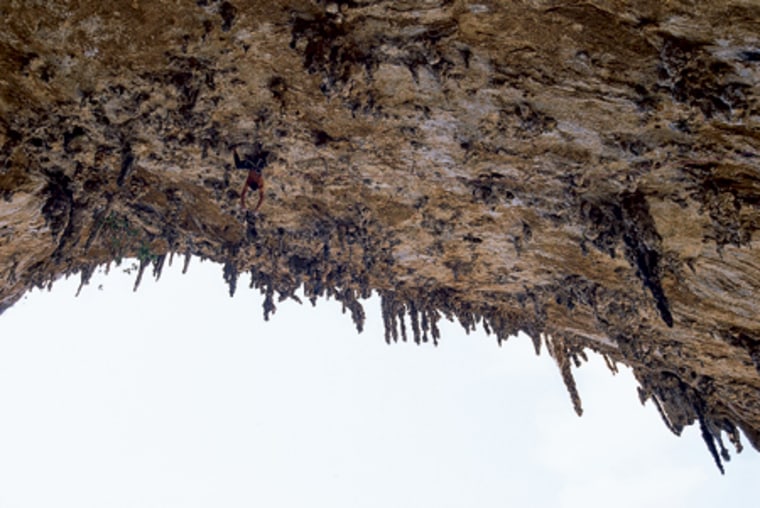
The original equipper, Guy (“Gee”) Abert, was on Kalymnos and had plans for the route. The scraggly, old-school Marseilles climber had thrown in the towel for routes in the 8a-and-above range, but was traveling with the extremely motivated Daniel Dulac. Abert’s passion now lay in photographing the various unclimbed projects he had left scattered across Europe, and Dulac was happy to assist. The younger climber bagged gem after pre-equipped gem, while Abert derived vicarious pleasure from his protégé’s success — and shot many saleable photos in the bargain. Abert had intended Fun de Chichunne for Dulac.
Legrand wanted in. The festival organizers had promised the invited rock stars a selection of unclimbed routes in the 8a to 9a range, but this hadn’t quite panned out. Though a large team of equippers created some wild lines, many of their offerings proved either too easy or impossible. Unclimbed rock of the correct difficulty was at a premium, and during one slide show I had heard Legrand grumbling about the shortage of projects.
Whatever. Dulac, it turned out, had become enamored with the multi-pitch climbing on a new cliff he had found — the one he raced off to with George’s new drill bits the day we arrived on the island — and at some point Legrand got the nod to try the Grande Grotta project, the last unclimbed line in the sector, which has now been closed to further bolting to protect the delicate stalactite architecture. I took up a position near the back of the cave, cursing the bad light. Legrand stood below the route, which overhung some thirty meters, arching out through the massive amphitheatre to end in a small hanging cave at the Grotta’s lip. Legrand racked twenty-some draws and tied into an extra-long rope, belayed by none other than Andrea Di Bari, the Italian who discovered Kalymnos for climbing.
Legrand set off to onsight. Above the opening moves, the holds thinned to cauliflower-sized concretions stuck to the ceiling and stalactites only a few inches in diameter. Legrand moved through the delicate features with the care of an ice climber, seeming to know just how much to press or pull on the frighteningly thin columns of flowstone. His arms and legs moved instinctively into exotic stemming and wrapping combinations. A few tiny flakes and pebbles came down from the route, but to my surprise François seemed completely unfazed.
About eighty feet out the roof Legrand stalled at the crux section that had stopped all previous climbers. He tried a couple of sequences, retreating to an inverted rest in a pair of slim stalactites. When Legrand moved out of the rest a third time there was urgency in his movements. Pinching tiny cauliflowers and throwing a powerful drop knee, he yarded through a long sequence of dead-horizontal climbing that hurt my abs just to watch, finally working into a partial rest among some larger, but perilously delicate features. The final climbing beyond him looked much easier, with stalactites several meters long providing a woods-like passage to the hanging garden at the lip. It looked like he had it.
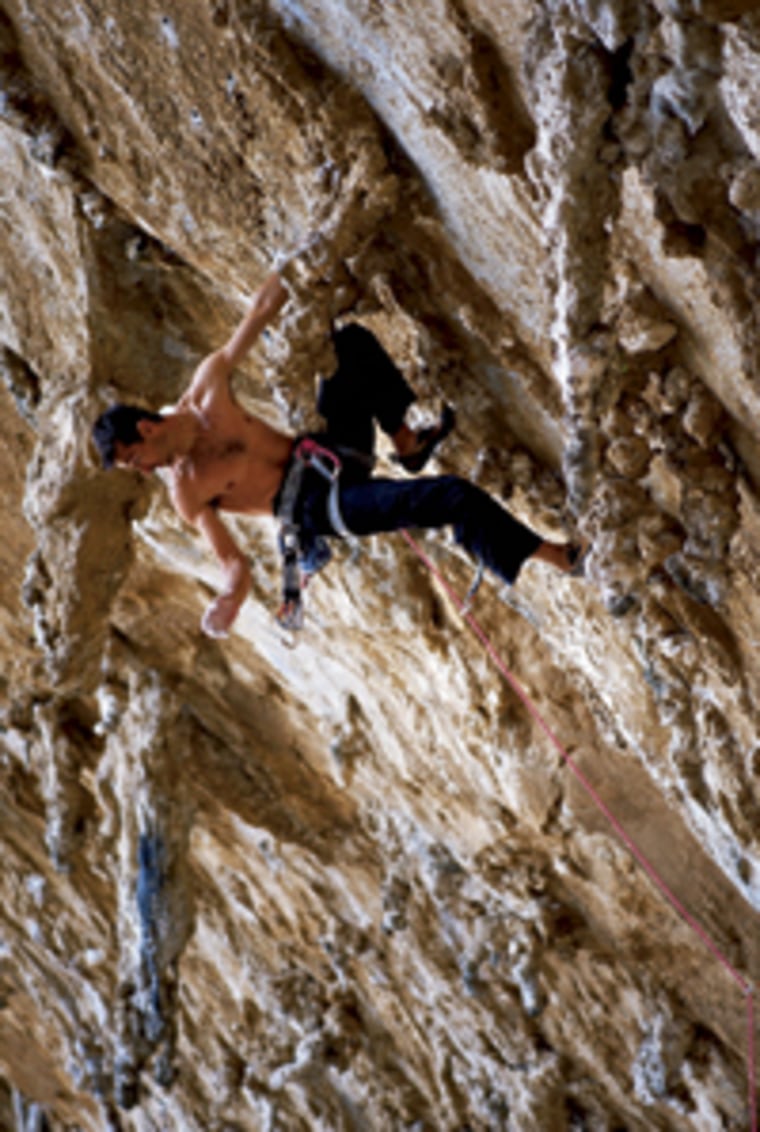
Legrand stemmed out, adjusting his stance — and then a stalactite snapped. Fragments of rock flew through the air, as did the Frenchman. The crowd below scrambled for cover. The rope zipped through the draws and went taught among the daggers of limestone. Legrand dangled, miles from anywhere, overlooking the shimmering waves of the Aegean Sea.
How many ways can you blow an onsight? I don’t know, Francois, but that way was one of the best. (Fifteen minutes later, on his next attempt Legrand made the first ascent of Fun de Chichunne, 8a+. A week later, Dulac onsighted the line.)
I witnessed other memorable performances over the course of the festival: Dulac redpointing a stunning, just-over-vertical pitch at his “Olympia” sector that he called 8b+ (5.14a), which would make it the hardest pitch yet done on the island — and part of a yet-unfinished three-pitch line; Mirjam Verbeek after about twenty pitches of 5.11+ and 5.12 climbing over the course of the day, coming within three moves of onsighting the mega-classic guidebook-cover route Aegialis (7c, 5.12d) in the last rays of a gorgeous Mediterranean sunset; an impromptu midnight street dance to celebrate the fortieth birthday of our new Austrian friend Marcus; Dave Graham crashing his scooter while trying to talk to his passenger and make a U-turn at the same time.
What did you think? I asked Tracy on the flight home. She summed up the Kalymnos experience quite nicely. “You felt like when you were there that you had no troubles — that it was just kind of paradise. If you were having an off climbing day or a tired day you could just go to the beach, which was what you were thinking about the whole time you were climbing anyway.”
Like the poster said, “a climbing paradise in the Aegean ...”
KALYMNOS: A TOUGH ROAD TO PARADISE
Though you would not know it from the warm hospitality climbers find on the island, tourism has not figured large in the Kalymnians’ past. Tiny, rocky Kalymnos, one of the easternmost islands of Greece, has always been overlooked by island hoppers in favor of other islands that are more lush, hospitable, and wealthy.
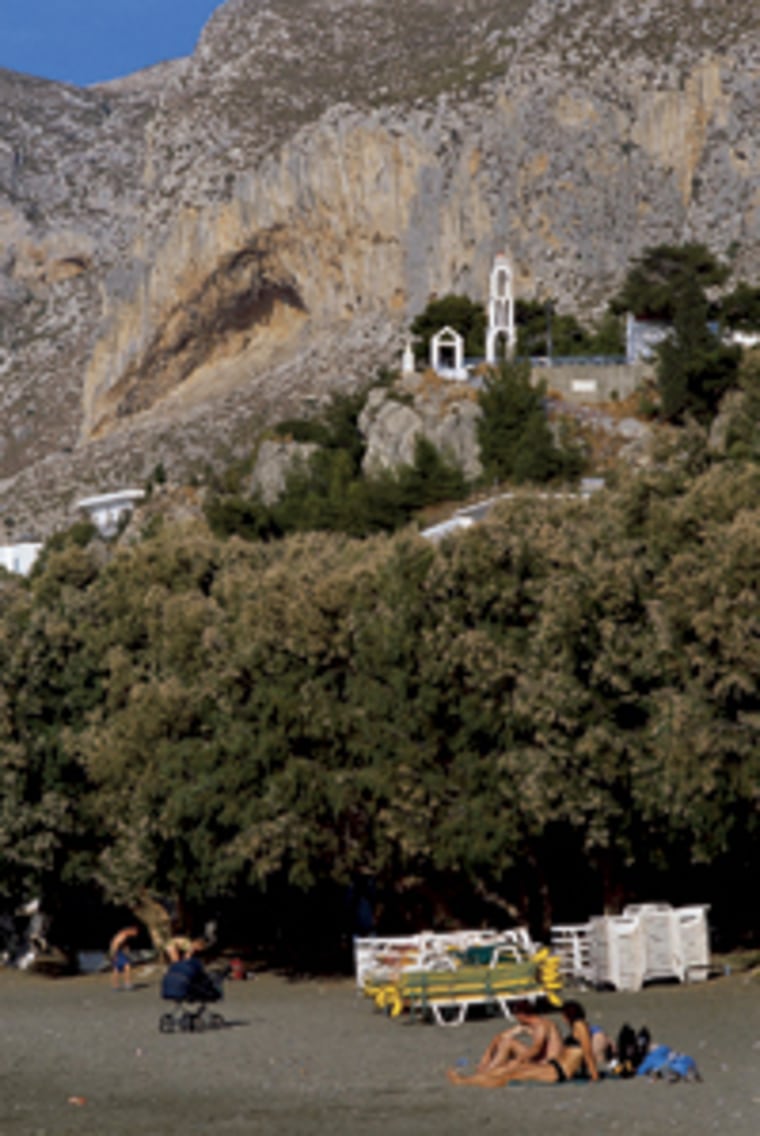
The more rugged way of life on Kalymnos dates back over 3000 years, when Minoans, Cretans, and then Dorians inhabited the island. Lacking opportunities for agriculture, and strategically located near Asia Minor, ancient Kalymnians made a living as seamen and warriors. According to The Iliad, Kalymnos sent 30 ships to the Trojan War in 1200 BC.
Throughout the ages, the fate of Kalymnos has been tied to nearby Kos, a famously rich island in ancient times, visible to the south from the shores of Kalymnos. Kalymnians took goods from the richer and more fertile island in exchange for helping to protect Kos from the ravages of pirates and would-be invaders. In one ancient battle (the resulting legal case was studied by Julius Ceasar when he was a law student), Kalymnians destroyed a dangerous pirate fleet off Cape Krikelo on Kos, but the governors of Kos shortchanged the Kalymnians, beginning an enmity that has existed between the two islands ever since.
Kalymnos was aligned with Alexander the Great, and later became part of the Roman Empire. Though the region flourished in Byzantine times, it was frequently attacked by Arabs and Turks, and by the 11th century, prosperity had been replaced by hardship from constant piracy.
In 1204, Venetians conquered Kos, followed a century later the Knights of Saint John, but in 1522 the Turks finally took the region and controlled it until the 20th century. Coinciding with the arrival of the Turks, the Kalymnians began to specialize in another grueling and dangerous profession: sponge fishing. Though the sponge industry has now all but died, Kalymnos gained great and lasting fame as “the sponge fishing island.” The arduous, hypoxic work of stripping the fibrous sponges from submerged rocks at depths up to thirty meters claimed the life of many a free diver. In the 19th century, the profession took on a more sinister industrial character, as Kalymnians unwittingly did trial-and-error R&D on the new helmeted deep-sea diving suits, resulting in the early case studies in the crippling and fatal effects of the bends. As local opportunities declined, Kalymnian fishermen worked as far afield as Africa and Key West; the town of Tarpon Springs, Florida, is composed largely of Kalymnian descendants who once worked the sponge trade, and the town was known in the 1930s as the sponge capital of the world.
Kalymnos, like all the Dodecanese islands, is thoroughly Greek, and participated in the Greek Revolution in 1821, but the London Protocol of 1830 did not include it inside the boundaries of the Greek state, leaving it to the Turks. Such hard luck — and the toughness that comes with it — have deeply influenced the local character. Kalymnians have been in the forefront of every struggle, winning decisive battles over the centuries, yet in peacetime they have been the first to be traded away by diplomats.
The Turkish occupation lasted until 1912, when the Italians invaded, but the initial promise of liberation soon gave way to an even harsher occupation as fascism took over in Italy. In the 1920s, Mussolini’s vision of a new Roman empire spread to the Dodecanese, though as with all eras of history, these cultural currents left almost no architectural imprint on the desolate, rocky island, or changed its tough inhabitants. Despite the richness of events, there are almost no ancient ruins or early architecture on Kalymnos; for these you must visit Kos.
The Fascist and Nazi domination of the 1930s and 1940s fell hard on the island, but one famous show of Kalymnian character came in April 1935, at a time when the Vatican was trying to pull the Dodecanese islands away from the Greek Orthodox Church and military and religious matters were thoroughly entangled. Trying to protect their local priest while their men were elsewhere engaged, 2000 women and children of Kalymnos entered into a three-day battle against Italian troops, armed only with kitchen utensils and stones. Early in the confrontation, one nun snatched a rifle from a soldier’s hands and broke the bayonette blade over her knee. In the struggle, six Italians were thrown into the sea by the mob of women, but to the credit of the occupying army, no Kalymnians were killed and the Italians finally quelled the rebellion. This colorful act of heroism, however, gained wide notice and helped turn the political tides, saving the religious freedom of the Dodecanese until the region finally gained independence at the end of World War II.
With the overfishing produced by dive suits and industrial methods, the sponge-fishing industry on Kalymnos dwindled, and the Mediterranean sponge blight of the 1980s finished it off as a viable industry on the island. Hard times once again fell on the Kalymnians. In the mid 1990s, as sun-loving climbers fanned out from larger Mediterranean islands like Mallorca, Sardinia, and Crete into more obscure locales, rock climbers chanced upon Kalymnos.
First were the well-known Italian rock climber Andrea Di Bari and his wife, who discovered the island in the summer of 1996. Andrea returned twice the next year with photographer Andrea Gallo and others, opening about 50 routes on the Arhi, Odyssey, and Poets sectors. The first Grande Grotta route, Aegialis, was put up in 1998 by Greek climbers George Kopalides and John Torelli. Italian climbers established the Jurassic Park sector the next year, Germans established the megaclassic Marci Marc (and the open project Lucky Luca) in 2000, and the Swiss contributed most of the superb Spartacus sector in 2002. Di Bari and Gallo published the first article about Kalymnos climbing, in the April 1999 issue of Alp magazine, and a climbing festival took place the next year. The island now has over 600 routes.
Kalyminans have long been independent, a bit iconoclastic, more at home among rock and sea than polite company and wealth. They are fiercely traditional and ill at ease with normal tourism, but quick to find commonality with adventurers and outcasts, a tendency that makes the island deeply amenable to climbers. The recent influx of climbing tourism is thus an odd but promising development for the island’s economy. “These rocks have been a curse to the island for centuries,” Kalymnians will tell you incredulously, “and now they are our blessing.”
LOGISTICS
Seasons: Spring and fall are best, and the sea is warmer in the fall. Winter climbing can be excellent, especially on the longer sunny routes, though this is the most likely time for rain. Climbing goes on in the summer months, though this is the height of the regular tourist season, prices and crowds are at their maximum, and the weather tends to be not only hot but windy.
Getting there: It takes almost two days from the States to get established on Kalymnos. The best place to base is the strip of beach towns on the northwest side of the island, Mythria, Masouri, and Amphos. Once there, you can reach the climbing on foot or by scooter.
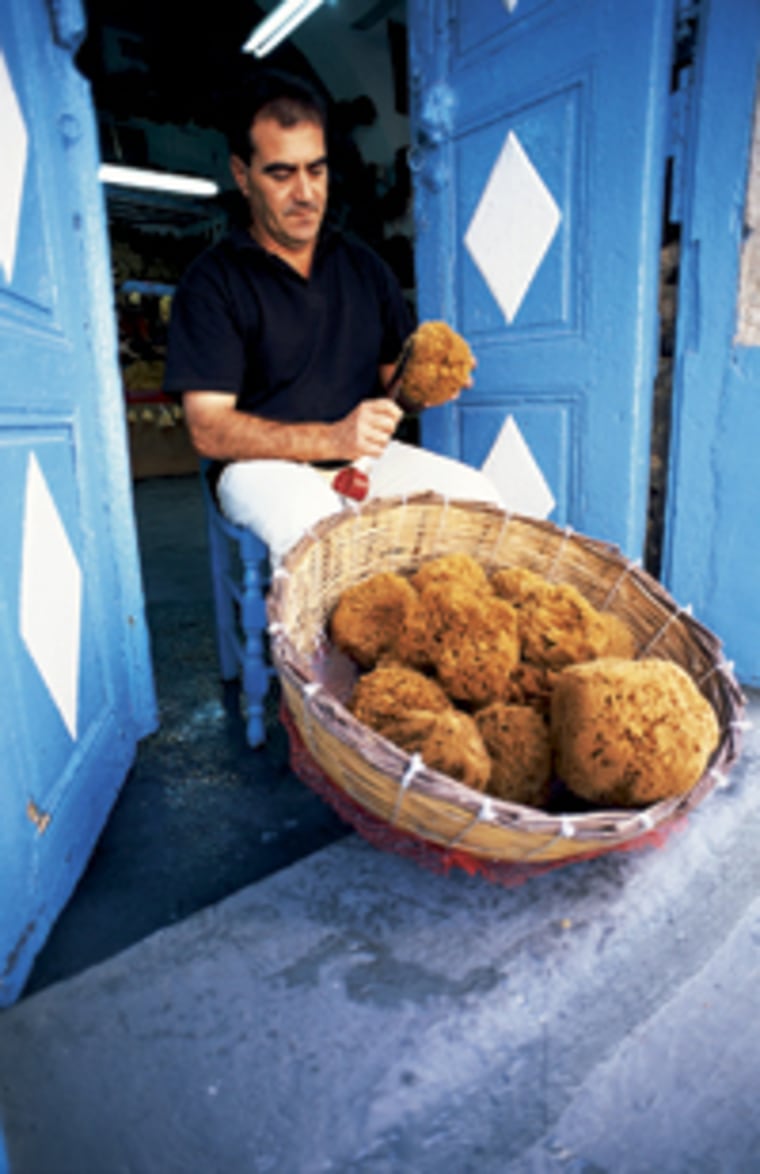
Fly to Athens, and then take a three-hour hop on Olympic or Agean airlines to the island of Kos, the closest airport to Kalymnos. There are two Athens-to-Kos flights per day; roundtrip is about 150 Euros. Once at the Kos airport, take a bus or taxi (10 minutes, 12 Euros by taxi) to the port town of Mastichari, departure point for the ferry to Kalymnos. Boats leave three times per day; there should be a boat that corresponds with your air arrival from Athens. If the ferry is delayed by high winds, which occasionally happens, you can stay in the city of Kos, founded in 700 BC, which has ancient architecture absent in Kalymnos. Hippocrates, father of medicine, was born in Kos, and the island even has a granite bouldering area, about 20 minutes from the Kos airport. To get there from the airport, drive to Antimachia and turn right to the village of Kardamena on the south coast of Kos. From there follow the road to Noridas Beach, which sits below a huge hotel group. One hundred meters before the hotel, turn left on a gravel road that leads to a chapel. Park there and stroll to the rocks.
The Kos to Kalymnos ferry costs 3.50 Euros, takes about 45 minutes, and lands at the busy port town of Pothia, on the opposite side of Kalymnos from the climbing. By taxi, it's a 15-minute, 8-Euro ride to the northwest beach towns.
It is also possible, and cheaper than flying to Kos, to take a ferry direct to Kalymnos from Piraeus, the main port of Athens, about a 12-hour ride. The Kalymnos-to-Piraeus return is an overnight trip, leaving in the evening and arriving at about 7:00 the next morning. Basic fare is 25-30 Euros, or 35-40 per person, double occupancy, for a small berth with beds.
Lodging: You will want to base out of Mythria, Masouri, or Amphos on the northwest coast. Directly above these towns is the huge cliff escarpment that contains the most popular climbing sectors on Kalymnos. If you have an hour of daylight left after checking into your hotel, you can hike to the crag and do a route in the Grande Grotta before the sun sinks into the Agean. You can easily book a room in advance through the internet (www.kalymnos-isl.gr/webweaver/climb/eng/accomodation.html). It's hard to go too far wrong, but the best value may be Lambrinos Studios, at 20 Euros a night for an apartment. Apartments located below the road are more expensive, but are nearer to the beach and protected from street noise, including that from the scooters that most climbers rent (about 7 Euros per day) for the short commute to the crag. You can walk to many of the main zones, but you'll need some transport for reaching the more out-of-the-way sectors such as Arhi or for sightseeing on the island. Camping is not allowed on Kalymnos. This lightens your luggage without being much more expensive than staying at many European campgrounds. If you're traveling in a group of four, you can manage on $10 or $15 per night for a room with a kitchenette, walking distance from the sea, the rocks, and all the bars.
Miscellaneous: Kalymnos is easily investigated on the web, but here are a few details: There are internet cafés near the crags. Traveler's checks are optional; you can use your ATM card in Masouri to withdraw cash directly from your U.S. bank account, in Euros. Restaurants are plentiful and cheap. Greek food is diverse and vegetarians will thrive on meals such as feta cheese served with olive oil, tomatoes, and cucumbers, followed by a veggie mousaka (eggplant casserole). Fresh fish, shrimp, calamari, and octopus are widely served. Another specialty is the local honey, aromatic with native oregano and thyme and famous throughout Greece. Adventurous carnivores should go for the goat dishes. Drink the retsina, a white wine seasoned with pine resin, only if you're planning a rest day.
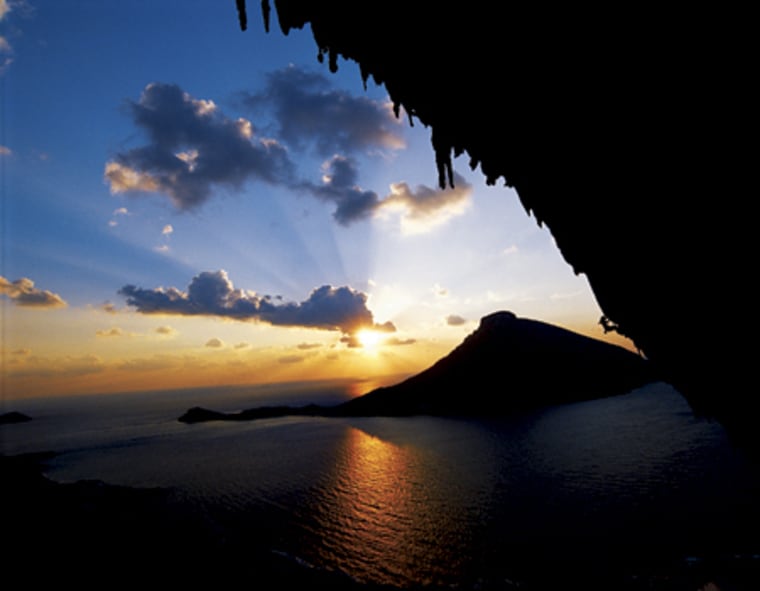
There are enough climbs of 6b (5.10d) and below on the island to keep climbers of modest ability happy forever. Easy and hard routes are scattered through most sectors, so groups of different abilities can climb together. If you function anywhere near the 7c (5.12d) level, bring a long rope. Many of the newer lines and extensions in the large caves offer world-class big-hold endurance climbing, and some require an 80-meter cord. Even some of the 5.11s, most notably the Grande Grotta route Trella, require a 70-meter rope. As with many "resort" climbing areas, the bolts in Kalymnos are closely spaced and the grades a bit soft, so don't be afraid to push yourself up the scale.
Multi-pitch climbing in Kalymnos is not yet very popular, but there are numerous hidden adventure climbs that are worth the risk of getting hot, thirsty, and late for the bar. Most are south facing and best done in the cooler months or early in the day. There's no need to bring any trad gear, just a 60-meter rope and a thin tag line for rappelling.
Jeff Achey is the Editor in Chief of Climbing.
